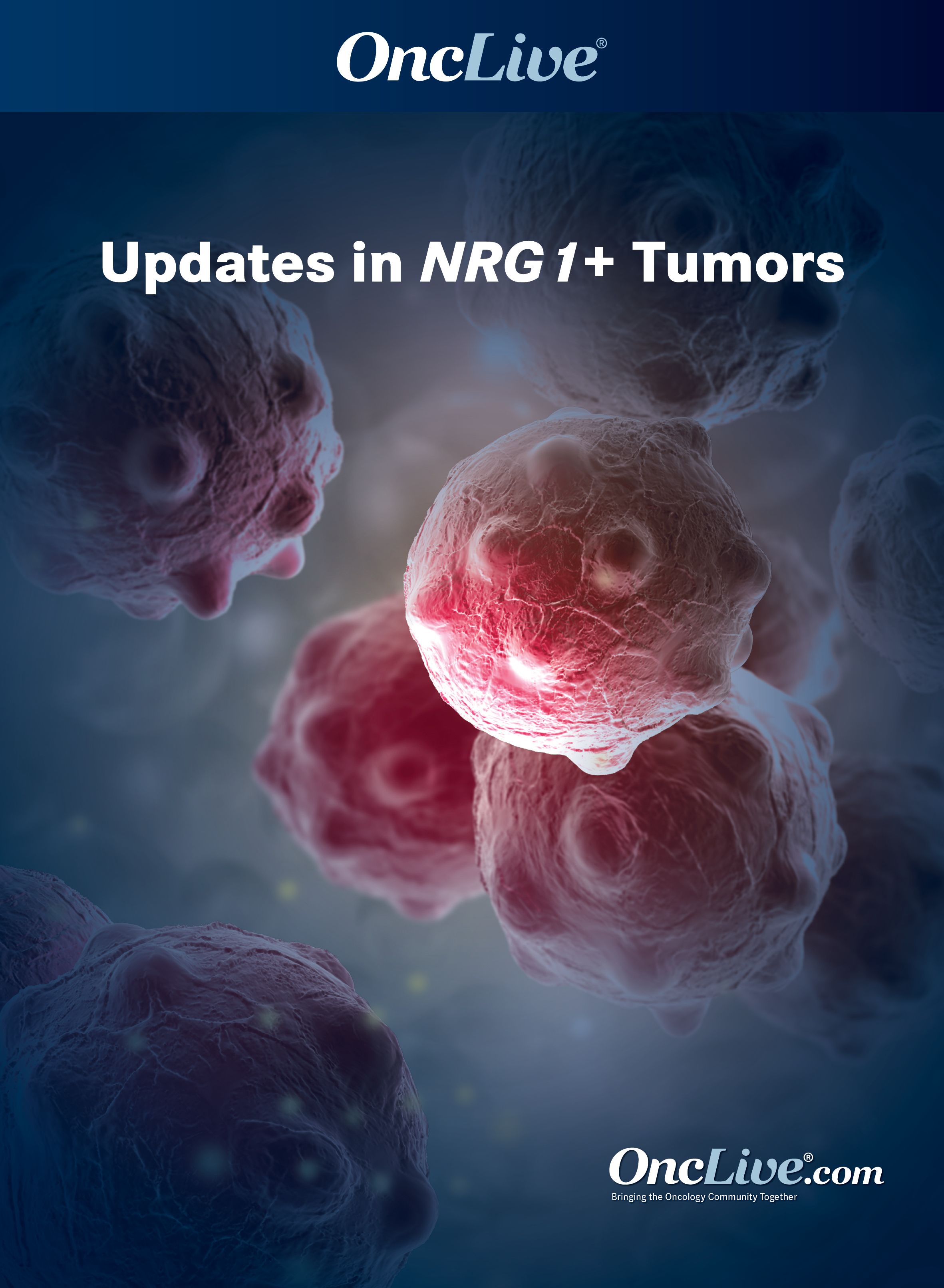Publication
Article
Supplements and Featured Publications
NRG1 Fusions Confer Low PD-L1, Low TMB, and Limited Immunotherapy Responses in Lung Cancer
Author(s):
NRG1 fusions, which are often first detected by RNA-based sequencing, confer a more molecularly, pathologically, and clinically diverse subtype of lung cancer compared with historical hypotheses.
Alexander Drilon, MD

NRG1 fusions, which are often first detected by RNA-based sequencing, confer a more molecularly, pathologically, and clinically diverse subtype of lung cancer compared with historical hypotheses, according to data from the eNRGy1 Global Multicenter Registry that were published in the Journal of Clinical Oncology.
Notably, these tumors, which are often PD-L1–low or –negative and have low tumor mutational burden (TMB), are modestly responsive to a variety of cytotoxic, immune-based, and targeted therapeutic approaches.
In the dataset, 72% (n = 33) of tumors (n = 46) had no PD-L1 expression, whereas 24% (n = 11) had PD-L1 expression of 1% to 49% by immunohistochemistry (IHC).
The median TMB was 0.9 mutations/megabase (range, 0-2.6; n = 11) in patients with NRG1 fusion–positive lung cancer. This was lower compared with patients with mutations in ALK (1.8 mutations/megabase; P = .03; n = 157), ROS1 (2.6 mutations/megabase; P = .0008; n = 85), RET (2.6 mutations/megabase; P = .0006; n = 95), and NTRK1/2/3 (4.9 mutations/megabase; P = .003; n = 13).
“Comprehensive sequencing to identify NRG1 fusions should capture molecularly heterogeneous events and not be biased toward particular clinical or pathologic features. To develop novel therapeutic strategies, stakeholders should prioritize research into the underexplored biology of NRG1 fusion–positive tumors and the development of rationally designed drugs,” lead study author Alexander Drilon, MD, a medical oncologist and chief of the Early Drug Development Service at Memorial Sloan Kettering Cancer Center, and co-authors wrote in the study publication.
Lung cancer is a disease enriched with genetic activating fusions, some of which encode cancer-driving chimeric oncoproteins. Proper identification of these aberrations can match patients to highly efficacious, approved targeted therapies.
NRG1 fusions have been observed across many tumor types, including lung cancer, but they have been historically difficult to characterize because of their rarity. Given the mechanism of NRG1 fusions, potential approaches to target the fusions have centered around inhibiting ERBB2 and/or ERBB3.
The eNRGy1 global multicenter consortium aimed to characterize the clinical, pathologic, and molecular features of NRG1 fusion–positive cancers, as well as their responsiveness to systemic therapies.
Investigators included in the consortium were identified by prior contributions to existing registries for other molecularly defined subtypes of lung cancer.
Eligibility criteria for patients stated that they needed to have a pathologically confirmed diagnosis of lung cancer that harbored an NRG1 fusion identified by an accredited laboratory by certain assays of fluorescence in situ hybridization, DNA- or RNA-based next-generation sequencing, reverse transcription-polymerase chain reaction, or detection of imbalanced gene expression.
The data submitted were anonymized to a database maintained at a single institution between June 2018 and February 2020.
Most patients included in the dataset (n = 110) were female (n = 62; 59%), Asian (n = 43; 52%), and never smokers (n = 48; 57%) living in the United States (n = 47; 43%). Patients were a median of 64 years old (range, 29-88). At diagnosis, most patients had stage I disease (n = 26; 32%), followed by stage IV disease (n = 24; 29%), stage II disease (n = 19; 23%), and stage III disease (n = 13; 16%). The vast majority of patients had adenocarcinoma (n = 103; 94%), most of which was invasive mucinous (n = 59; 57%). In patients with metastatic disease (n = 44), the most common sites of metastasis were the lung (n = 31; 71%), bone (n = 15; 34%), and lymph node (n = 10; 23%).
Additionally, of the patients with a prior smoking history (former, n = 25, 30%; current, n = 11; 13%), the median pack-year history was 37 (range, 1-135).
The majority of NRG1 fusions were identified by RNA-based assays (74%), followed by DNA-based assays (26%).
Further results revealed that the median overall survival (OS) was not reached in patients with stage 1 disease at diagnosis (95% CI, 51.5 months-undefined) compared with 52.9 months for stage II disease (95% CI, 38.8-undefined), 78.2 months for stage III disease (95% CI, 11.0-undefined), and 15.5 months for stage IV disease (95% CI, 10.3-64.5).
Regarding the molecular features of NRG1 fusions, upstream gene partners were noted in 84% of fusions and breakpoints were noted in 61%. Moreover, 18 unique upstream gene partners were identified, 13 of which depicted known exonic breakpoints. The most common upstream partners identified were CD74, which was observed in 41% of fusions, and SLC3A2, which was observed in 20% of fusions. Less common partners included SDC4, FGFR1, ATP1B1, CADM1, DIP2B, F11R, FLYWCH1, ITGB1, KRAS, MDK, MRPL13, PLCG2, RBPMS, TNC, VAMP2, and VAPB.
The breakpoints for CD74 most commonly occurred after exon 6, whereas the breakpoints for SLC3A2 most commonly occurred after exon 5. The breakpoint most commonly involved with NRG1 fusions was exon 6, and all fusions included the EGF domain that bind ERBB3.
Additionally, NRG1 fusions were mutually exclusive with other known oncogenic drivers in 94% of patients (n = 103), whereas the remaining 7 patients had concurrent drivers, including KRAS mutations, EGFR mutations, or ALK fusions, some of which were present de novo.
Of the evaluable patients who received platinum-doublet chemotherapy (n = 15), 13% responded (n = 2). The disease control rate was 60% and the median progression-free survival (PFS) was 5.8 months. Patients who received a taxane following progression on a platinum doublet (n = 7) had a 14% response rate (n = 1), 71% had progressive disease (n = 5), and the median PFS was 4 months (95% CI, 0.8-5.3; range, 0.8-5.5).
Limited responses were observed with checkpoint inhibitors as well, which was consistent with the immunophenotype of NRG1 fusion–positive lung cancer.
Afatinib (Gilotrif), a pan-ERBB inhibitor, demonstrated a 25% response rate (n = 5) in evaluable patients treated with the agent (n = 20), but the most common response was progressive disease (60%; n = 12). The median PFS with afatinib was 2.8 months (95% CI, 1.9-4.3; range, 0.3-25.3) and did not differ in patients harboring a CD74 fusion partner vs other fusion types. No significant OS difference was observed either among patients who received afatinib vs not (P > .05).
“NRG1 fusions have a diversity of fusion partners and an EGF binding domain that binds ERBB3. The development of novel therapeutics for these cancers is thus an unmet need,” concluded Drilon and co-authors.
Reference
- Drilon A, Duruisseaux M, Han JY, et al. Clinicopathologic features and response to therapy of NRG1 fusion–driven lung cancers: the eNRGy1 global multicenter registry. J Clin Oncol. Published online June 2, 2021. Accessed June 24, 2021. doi:10.1200/JCO.20.03307































%20(2)%201-Recovered-Recovered-Recovered-Recovered-Recovered-Recovered-Recovered-Recovered-Recovered-Recovered-Recovered-Recovered-Recovered-Recovered-Recovered-Recovered-Recovered.jpg?fit=crop&auto=format)
%20(2)%201-Recovered-Recovered-Recovered-Recovered-Recovered-Recovered-Recovered-Recovered-Recovered-Recovered-Recovered-Recovered-Recovered-Recovered-Recovered-Recovered-Recovered.jpg?fit=crop&auto=format)
